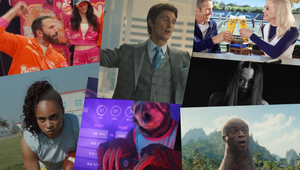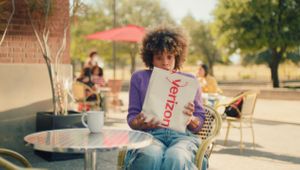
The VFX Factor: Corinne Deorsay on the Art of Balancing

Corinne Deorsay is a CG supervisor/lighter with nearly a decade of experience. After graduating with a degree in Digital Media from Drexel University in Philadelphia, she was exposed to Houdini after working with SideFX, and has been primarily working in Houdini ever since.
Corinne has worked with notable directors such as Adam Berg, Paul Haggis and Ian Pons Jewel, and for global brands such as Kia and Audi.
Her background is varied, working on commercials and game trailers, as well as feature films such as Wrath of the Titans and Beautiful Creatures.
After working as a CG Artist at renowned studios in Los Angeles including Method Studios and ETC, as well as MPC in 2013, Corinne joined the LA studio in August 2019.
Notable work at MPC includes Kia’s ‘Fully Charged’, Call of Duty’s ‘Advanced Warfare: Discover your Power’ and Jet Blue’s ‘Recurring Dream’.
LBB> There are two ends to the VFX spectrum - the invisible post and the big, glossy 'VFX heavy' shots. What are the challenges that come with each of those?
Corinne> I often find myself giving notes to artists to make changes 'so no one will ever look at it'. Invisible VFX is a challenge because as artists, we often want to make something beautiful, interesting, and eye-catching but that is counterproductive to the project's needs. VFX is often the art of balancing, and the hardest work is often creating something mundane enough that it won't distract from the main story.
Big VFX shots are often a challenge because you rarely have the time to let one artist handle everything, or even one discipline. The tasks are subdivided up into multiple modules for different artist to handle. Then the challenge is getting them all to fit back together properly. There's a lot more logistical challenges in the large shots, beyond just making the difficult bits of VFX.
LBB> As a VFX person, what should directors be aware of to make sure you do the best possible job for them?
Corinne> Good VFX takes planning and time. Spend time before shooting, planning out the VFX and speaking with the team that will be executing the final work. It's important to give the VFX time in the schedule. The more iterations you can have the happier you will be with the results. Also, try to be a little flexible and listen to the team's suggestions, they have your best interests at heart.
LBB> VFX is a true craft in the classic sense of the word. Where did you learn your craft?
Corinne> In university we had a strong computer lab culture where students across the different years really encouraged each other and shared knowledge. I would credit those four years with really giving me my worth ethic and the tools I needed to learn new things in the future. I'm still in touch with many of those friends, and cross paths with them in the industry. We're still helping each other 10 years later.
LBB> Think about the very, very start of a project. What is your process for that? Do you have a similar starting point for all projects?
Corinne> Most projects start with an intense 'research phase' to familiarise myself with the subjects for the next project. One of the fun side effects of working in VFX is you become a mini expert on something new for every project. It's important to learn the vocabulary you'll need for the next project so you can accurately talk with clients and team about what you're re-creating. Watching previous work by the same directors, agencies, and clients. Looking into other artist's techniques for solving the same technical problems and chatting with team members who have done something similar before. Those are my first steps for every project.
LBB> We imagine that one of the trickiest things with VFX is, time issues aside, deciding when a project is finished! How do you navigate that?
Corinne> That's a tough one! Is it ever really finished? Usually, it's the client-set deadline that has us finally dropping our Wacom pens or getting caught up in the next project.
LBB> Is there a piece of technology or software that's particularly exciting you in VFX? Why?
Corinne> I always love working in Houdini. I was an intern at Sidefx Software and I really enjoy their commitment to their software and users. I'm a bit of a fan.
LBB> Speaking of that, how have you navigated your role during Covid? Was there a big shift to remote? Tell us about your experience.
Corinne> Covid really encouraged the team at MPC LA to start operating like a global company. Prior to Covid, many projects were run locally, a small core team worked together (often in the same room) to collaborate and finish a project. With Covid came a few massive, full CG projects that required large teams to finish. We are now sourcing artists from all our locations to make sure we have the very best team. We quickly had to restructure our communication styles to keep a large team moving forward and in the loop across multiple time zones and locations.
LBB> Are there any lessons you've learned / experiences that you've had from working during Covid that you'll be looking to keep with you once things hopefully get back to some form of normality?
Corinne> I like the flexibility working from home gives artists. Waiting for other pieces of the pipeline to finish is easier when you're doing it from your home. I also think some people are really benefiting from the quiet of their home offices for solving technical problems. I do miss my co-workers a ton. We once ate lunch in the office parking lot (socially distanced, of course!) because we were missing that connection.
LBB> How did you first get into the industry? What was your very first job in the industry and what were the biggest lessons that you learned at that time?
Corinne> I went to school for 'Digital Media' and focused on working in 3D. When I graduated, I moved out to Los Angeles and got my first job working on a Disney TV Movie for a tiny studio, Mechnology, in Glendale. My coworkers were fantastic and taught me a lot about pipeline and how to work as a team to get a project done. I then took an internship with Sidefx Software where I solidified my path as a 3D artist who often works in Houdini.
LBB> What was your first creative milestone in the industry – the project you worked on that you were super proud of?
Corinne> One of my first projects was a Kia Hamster commercial that had a moment of viral popularity on the internet. There were only two of us rendering hamsters on the project, so I felt very connected to the final output. It also didn't hurt that it's still probably the most recognised project I've ever worked on.
LBB> From a VFX perspective, which ads have you seen recently that you've been particularly fond of and why?
Corinne> I really loved the Burberry commercial done in our London office. It was just a nice combination of good ideas, lovely cinematography, and very well-done VFX work. The team killed it on that one, and I'm proud to call them my co-workers.















